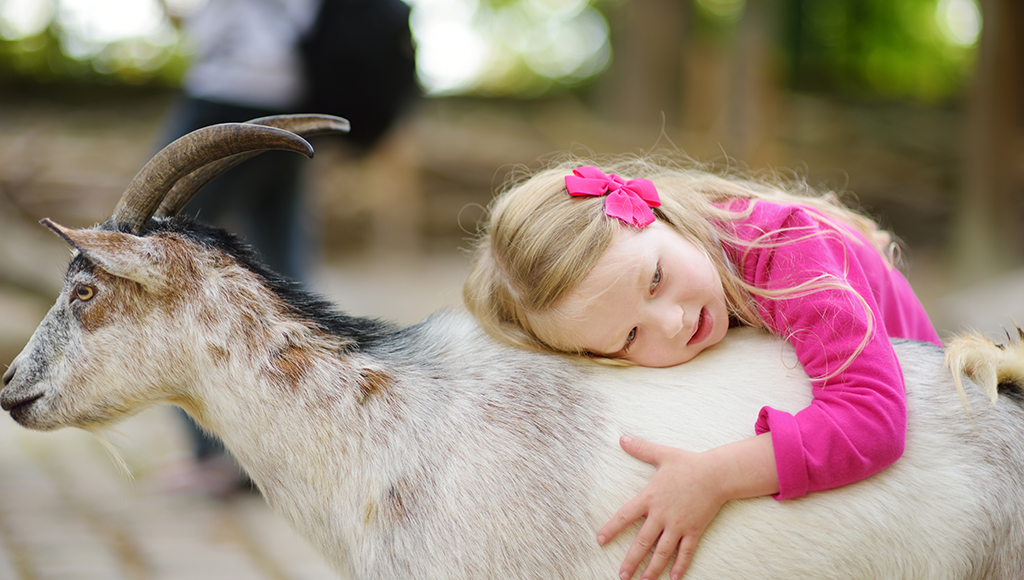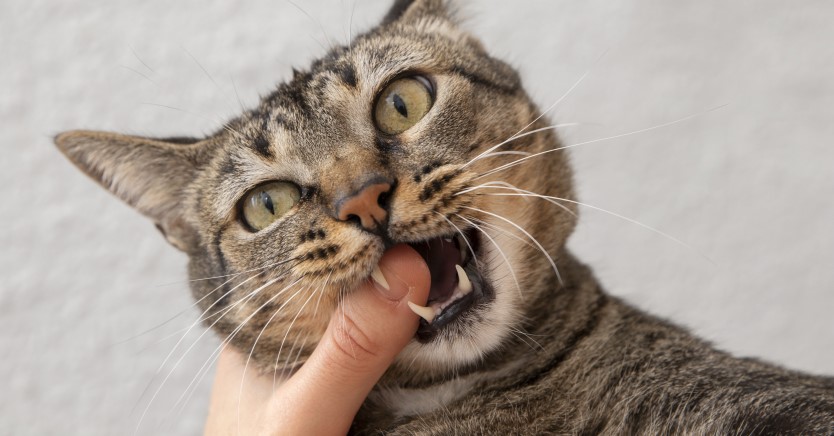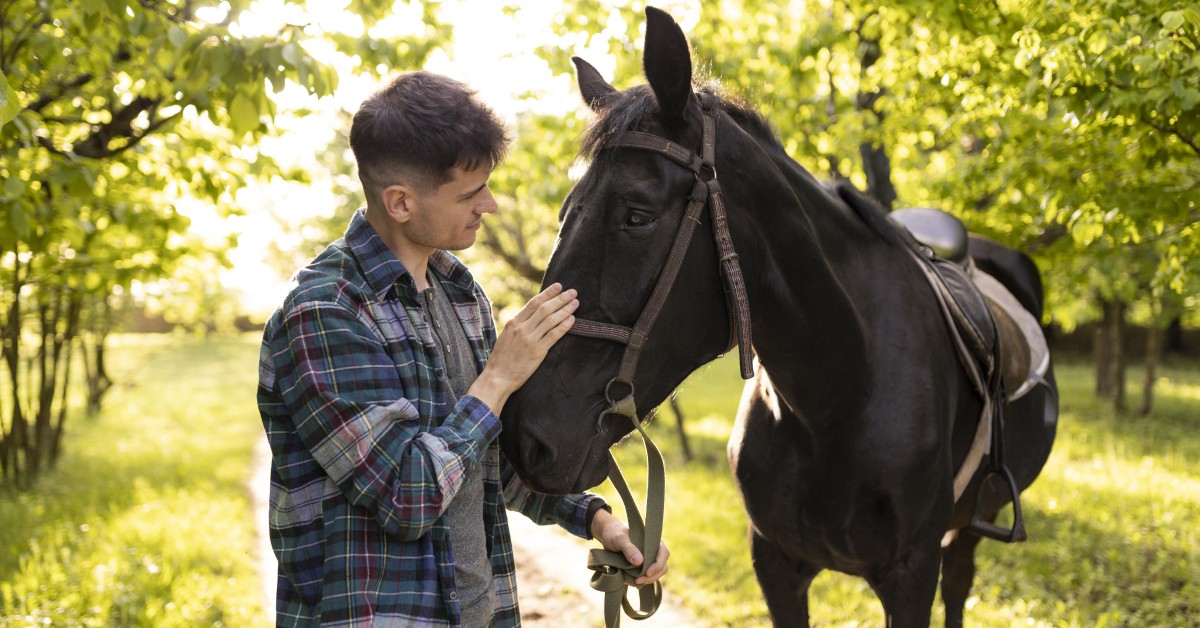From the Farm: Goats as Pets
Although they aren't normally kept as pets, goats can be fun and fascinating to care for.

This summer, we will show you some “unusual” pets, specifically from the farm community. Although they may not be the usual family pet, many farm animals do make delightful “outdoor” companions, and are fascinating creatures to care for. We’ll explore a different farm animal each newsletter throughout the summer.
Goats are cute, curious animals, and they make interesting outdoor pets and companions. From mowing your lawn to accompanying you on hikes, you'll find goats are enjoyable and challenging creatures with a lot of energy. Before attempting to keep a goat as a pet, there are some things you should consider:
- Know that goats are outside animals and training them to be inside pets is not practical, and not likely to be successful, no matter how determined you are. Unlike other unusual pets, such as pigs, they aren't likely to be house-broken or to cuddle with you. Appreciate that goats won't come running when you call their names either, but they might look at you if they like you.
- Goats are herd animals, so should not be kept as solitary animals. A pair (or more) of goats will make a good addition to the right family. A decent amount of space (yard/pasture) will be necessary, depending on the breed and number of goats you decide to keep. Goats are best suited for rural areas on farms or homes with large acreages. If you live in a city, bylaws may prevent you from keeping goats as they will likely be classified as an agricultural species. Please check for any local restrictions before acquiring a goat.
- You must also be prepared for the commitment to having goats. They do need attention like any other pet, and you need to consider who can care for the goats if you must go away, of if something should happen that means you can no longer keep the goat.
- Realize that goats are active and need attention. Goats can be extremely stubborn, so it’s important to realize that they don't respond well to harsh discipline when they do wrong, but do respond well to positive reinforcement like food. Goats are not a creature you can just ignore, or leave alone, as they can be quite curious and destructive, making a mess of things if left unsupervised for long periods.
- Give a goat a lot of roaming space. Goats need at least an acre of land (a really big yard), which should be fenced for their protection (e.g., a chain link fence is better than a wooden one).
- Provide shelter if you want to keep a goat as a pet. Understand that even though goats are outdoor animals, they still need a sturdy and safe shelter during bad weather. Make sure it's not made out of something they will likely eat or knock down.
- Supply food and fresh water. Goats need ample hay and grass. They like grain too, but they tend to gorge themselves if it's too easily available. Keep grain where goats can't get into it. Change their drinking water daily.
- Make goats happy with special treats, such as fruit, molasses, vegetable scraps and some hedge clippings. Save treats for special occasions since goats can easily gain weight by eating them too often.
- Walk your goat. Goats love to explore, and make good hiking buddies. They are steady on their feet during hiking, so you may even load a few supplies on them. Exercise goats often.
HOUSING
Goats are very adaptive animals and do not require fancy or expensive housing; they simply need protection from the basic elements. When it rains or snows, they will seek shelter. Goats can tolerate cold weather, but should not remain cold and wet for long periods of time. During the summer months, it is also important to provide a shady area with adequate air circulation to keep them comfortable and to control flies.
Natural shade and windbreaks will protect goats during much of the year. A dry, draft free area works well. Often times, existing buildings can be utilized to house goats, store hay and equipment. Confinement housing, which can be completely enclosed as needed, is popular in cold climates and for human comfort and convenience. Confinement housing allows close supervision of animals, but is more expensive than most other types of housing. Goats in confinement require 20 square feet of space, plus an additional 30 square feet for exercise, if a pasture is not available.
Three-sided or open-sided shelters are suitable in most situations. The open side should face away from prevailing winds, the roof should be sloped to repel rain, and there should be adequate drainage around the building. Goats require 10-to-15 square feet of space in open housing. If you have more than one goat, and have both males and females, Buck housing can be simple, but must be strong. Taller, sturdier fences are needed to keep the Bucks away from Does when they are in heat.
Movable sheds, polydomes, calf hutches, quansit huts, and straw buildings can also be used to shelter a small numbers of goats. Hoop or greenhouse structures offer an alternative to traditional livestock housing. In these structures, semi-circular tubular steel provides structural support to a covering of either polyethylene or fabric. The appeal of hoop structures is the lower cost of materials and construction.
Dirt or stone floors are preferred to concrete. Pens should be bedded with 3-to-4 inches of straw or other absorbent material (poor quality hay, wood shavings, sawdust, shredded newspaper, peanut hulls, or sand), 5-to-6 inches if the floor is concrete. In the winter, the manure pack should be allowed to build up, as the decomposing layers provide a source of heat. Buildings with expanded metal floors have been used successfully to feed goats. Less space is generally required per animal. Building plans for housing livestock are usually available at most county extension offices.
MANURE HANDLING
Goat housing should be designed with manure handling in mind. Unprotected piles of manure should not be stored in places where runoff may occur. It may be advisable to cover manure piles with tarps. Composting animal waste reduces odors and fly problems. Composted manure is an excellent soil amendment. Providing a large, outside area, comparable to a goat’s natural environment will greatly reduce manure handling requirements.
VENTILATION
Ventilation is an important aspect of animal housing, particularly closed housing. Poor ventilation can be detrimental to animal health. Harmful gases and dust can cause respiratory problems, while temperature extremes can reduce animal compatibility. The purpose of ventilation is:
- to provide the desired amount of fresh air, without drafts, to all parts of the shelter
- to maintain temperatures within desired limits
- to maintain relative humidity within desired limits
- to maintain ammonia levels below specified levels
Ventilation can be natural (cold housing) or mechanical (warm housing). Natural ventilation systems move air through adjustable and fixed openings, such as vents, windows and doors. Mechanical ventilation systems incorporate fans, controls, and air inlets and/or outlets.
FENCING
The importance of good fences cannot be overstated. A properly built fence stands for as long as it is needed, keeps goats where they belong, and provides protection from dogs and other predators. Fencing can also protect trees, shrubs and other sensitive areas from destruction by the goats.
Perimeter fences are usually permanent and intended to last for many years with minimal repairs. They should be constructed of high quality materials. Predator control should be a primary consideration. Interior fences may be permanent or temporary.
There are differing opinions as to what is the "best" type of fencing for goats. Some people choose to use different fence types in different situations:
-
Woven wire - or "field fence" is the
conventional goat fence. It consists of horizontal lines of
smooth wire held apart by vertical wires called "stays". The
spacing of the wires generally gets wider as the fence gets
taller. Woven wire has the disadvantages of being expensive and
difficult to install over hilly terrain. A four foot high woven
wire fence, with one-to-two strands of barbed or electric wire
along the top of the fence makes an excellent perimeter fence
for goats. High-tensile, woven wire fences are more expensive,
but do not sag or stretch as readily as standard woven wire.
They are more resistant to rust and are considerably lighter in
weight.
-
Barbed Wire - can be effective for goats if
the wires are evenly spaced and tightly stretched. Eight
strands of 15-½ gauge wire are recommended, with several
twisted wire stays between posts. Barbed wire fences are easier
and less expensive to construct than woven wire, but the barbs
can cause serious injury to animals and children, and the fence
will not effectively deter predators.
- Board fences - commonplace on many horse farms, are generally not suitable as either interior or exterior fences for goats unless the boards are close together or strands of wire are placed between the boards because kids and dogs can get through the gaps. While board fences can be very aesthetic, they are much more expensive to construct and usually require costly upkeep.
FEEDERS
Feeders are a necessity for goats. Feeding on the ground results in considerable feed waste and contributes greatly to the spread of disease, especially internal parasites. If goats are able to stand in their feed or feeders, they will defecate and urinate in the feed. Feeders need to be raised off the ground and constructed in such a way to keep goats out (as much as possible).
There are various designs for grain feeders. V-shaped feeders are easier to clean than feeders with square bottoms. Rubber or metal pans are useful for hand feeding small numbers of goats. Feeders that can be hung on the side of the fence, then removed after the goats have finished eating, are especially effective.
Hay can be fed in bunks or racks or along a fence line. V-shaped racks with vertical or diagonal slats work best. A toe board will help keep the goats' feet out of the feeder. Round hay bales should be fed in feeders with movable sides or an overhead rack.
There should be enough feeder space for all goats to eat at once. Ideally, you should be able to access feeders from outside the pen or pasture to prevent being trampled by the goats during feeding.
It's a good idea to hang mineral feeders higher than the goats can reach, then provide a block for them to stand on. If fed outside, a lid is needed is needed to keep the mineral dry.
Building plans for feeders are available at most county extension offices.
WATER
Clean, fresh water is a daily necessity for goats. As a general rule of thumb, goats will consume anywhere from ½ to 4 gallons of water per day, depending on their physiological state. Feed intake is positively correlated with water intake.
Water can be free flowing or provided in buckets, troughs, tubs, stock tanks or automatic waterers. It goes without saying that water sources should be kept clean and free from hay, straw, and fecal matter. Smaller troughs are easier to drain and clean. Water will be more readily consumed during cold weather if the water is ice-free and during hot, humid weather if the water trough is in the shade.
FEED AND STORAGE
All feed – hay, grain, trace mineral salt – needs to be kept dry and protected from rodents. Feed must be accessible in all weather conditions, but inaccessible to goats. Moreover, ample feed storage can result in considerable cost savings if feed ingredients can be purchased and stored in bulk.
Unprotected hay deteriorates in quality. Hay should not be left uncovered. Hay bales should be stored in hay lofts, storage sheds or covered with tarps. Hay and straw bales should not be placed in a barn unless they are thoroughly dry; otherwise there is risk of overheating and fire.
A bulk grain bin can prove to be a good investment. It enables you to accept bulk deliveries of grain or purchase directly from grain producers at farm gate prices. Salt and minerals and smaller amounts of grain can be stored in barrels, garbage cans or old freezers/refrigerators.
OTHER THINGS TO REMEMBER:
You should first find a veterinarian who will treat your goat. They are susceptible to a number of infectious and chronic diseases. Vaccinations and routine preventative treatment for worms and other parasites are necessary and you should consult a vet for what is required in your area.
Be sure your goats are obtained from a conscientious breeder that practices good preventative medicine. If possible it is always best to visit the breeder so you can see in what sort of conditions their goats are kept.
Most importantly, you will want to think about whether you can meet the needs of a goat and whether goats will meet your expectations as a pet before committing to goats as pets.
Ready to start saving money on pet wellness care?
Then take a look at Mint Wellness, the pet wellness plan that provides fast reimbursement on routine pet care. Save on vaccinations, wellness exams, preventatives, dental, and more!
Learn More


